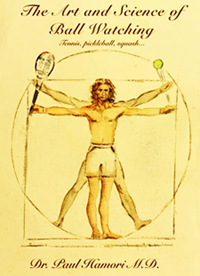Tennis and the Brain
Paul Hamori, MD

Martin Samuels, the famous Harvard neurologist has said, "your brain is you." This article explores the miracle that is the brain and how it allows us to play our beloved sport, tennis.
In the course of my work as a physician I've uniformly found that the one disease people fear the most is dementia. More than cancer, more than heart disease, more than infections, people are worried about losing brain function–because your brain is you, and when you lose it you lose you.
The good news is that tennis helps preserve the brain. So not only is tennis fun, it turns out to be great for you.
In a now famous study by Dr. Jacqueline Dominguez, it was found that the number one activity that correlates with reduced risk of dementia was ballroom dancing. It reduced the chance of developing dementia by a whopping 76%.
For comparison frequent reading reduced the chances by 35% and, I'm sorry to report golf reduced it by 0%. It is theorized that the reason ballroom dancing is so effective at preserving brain function is that it combines complex physical activity (aerobic exercise with foot and arm movement), correlating said movement with music, remembering the proper steps, interfacing with a partner, and making on the fly adjustments and decisions in real time.
Dr. Joseph Coyle of Harvard Medical School stated "the cerebral cortex and hippocampus, which are critical to these activities, are remarkably plastic, and rewire themselves based on their use." This helps preserve what we call the synaptic entanglement–all the connections between neurons that allow and preserve complex brain function.
Although not studied specifically, I would argue that tennis is remarkably similar to ballroom dancing. Tennis involves aerobic exercise moving the arms and legs, complex footwork and balance (similar to dance steps–great players have been compared to ballet dancers in their movement), tracking the ball for sound, trajectory, angle, speed, spin and bounce.
You need to know your position on the court and your opponent's position at all times. And in the case of doubles you are tracking 3 players and yourself simultaneously. Tennis is unpredictable and on the fly decisions are the rule, not the exception. Additionally, tennis has a social aspect, and socializing has also been shown to preserve brain function.
Brain Facts

So let's explore some brain facts to understand how all this gets accomplished. In his most recent book The Body, popular author Bill Bryson enumerates brain facts in an extremely accessible way. I find his descriptions eminently understandable and so I'm going to use some of them here (anything in quotation marks in this section is from Mr. Bryson–unless specifically stated otherwise).
Bill is an assiduous researcher and typically he travels the globe interviewing expert scientists, and really tries to understand the science and then translates it for non-scientists. As a physician having studied all of these subjects I still find his presentation of the subject matter nearly perfect–adequately detailed but eminently understandable even for the non-scientist.
In a physical sense the brain is an amorphous blob of tissue consisting of protein, fat, and water–that is it. I like to think of it as being like a big piece of tofu.
"This mass sits inside our skull in complete darkness. It never sees light, it never hears sound, it never feels touch. And yet this mass of tissue generates our entire reality out of electrical pulsations it receives."
Really, it's unbelievable: "The great paradox of the brain is that everything you know about the world is provided to you by an organ that has itself never seen that world." There are 85 billion neurons in the brain. Half of those are in the cerebellum which is devoted to movement and balance, the remainder are in the cerebrum and lower brain structures. "Those 85 billion cells each may have as many as 400,000 connections with other cells leading to many trillions of synaptic connections"–the so called synaptic entanglement.

Neuroscientist David Eagleman states "in a single cubic centimeter of brain tissue there are as many connections as there are stars in the Milky Way". This gives rise to computing power that is really humbling: "a morsel of cortex about the size of a grain of sand could hold 2000 terabytes of information, enough to store all the movies ever made, trailers included."
"The entire brain holds on the order of 200 exabytes of information, roughly equal to the entire digital content of today's world." And what do we get with all of that computing power? Things we often take for granted but when enumerated are nothing short of mind boggling: Naming only a few–Vision, hearing, balance, touch, language, taste, smell, aesthetic appreciation, thinking, knowledge, consciousness, bipedal ambulation and the ability to move about a tennis court and track and hit the ball for entertainment.
3 Aspects
I would like to explore 3 aspects of brain function as related to tennis. These are Balance/movement, hearing, and vision.
The fact that human beings can walk on two legs is in and of itself astounding. If you have ever seen a robot attempt bipedal ambulation–even with today's technology, it is a pretty sad state of affairs.
The levels to which we humans take movement in our athletic pursuits is even more amazing. Looking at tennis specifically, the type of footwork required to set up for ground strokes and volleys, move and cover the court from corner to corner and front to back, leap into the air for serves and overheads while still landing in a balanced fashion ready to continue moving is a thing of beauty to behold.
It takes nearly half of the cells in your brain, about 42.5 billion cells to accomplish this task. You may have heard the phrase tennis is a game of moving with some hitting (not a game of hitting with some moving).
In addition to the 42.5 billion cerebellar cells, we also make use of the vestibular system. This is the so-called gyroscope in your skull. This balance organ consists of 3 semicircular canals oriented in 3 different planes and filled with a potassium rich fluid called endolymph which then allows us to sense movement, direction, acceleration and deceleration.
All of this gets integrated through complex motor systems controlling muscles in our extremities and core. Also critical to this process is proprioception or the ability to know where your limbs are in time and space. All of this activity goes on in an automatic fashion without much conscious thought.

Hearing is an underrated special sense with respect to tennis. Although sound travels slower than light, at short distances (less than 25 feet), experts feel hearing is actually processed faster than vision. Fortunately our brain integrates the senses even though there are miniscule differences in their processing speeds.
That said, sound can be used to facilitate better tennis play. For instance when receiving serve, I believe we pick up on the sound of the hit more quickly than the visual aspect.
Immediately as your opponent strikes a serve you can hear whether it's a spinner or a heater. That is why you will see professionals insisting on quiet before points are started. They want to be able to hear what's coming at them.
When we are striking the ball, hearing can also be extremely useful to guide our understanding of the visual window of attention. When we hear contact, making a conscious effort not to follow the outgoing ball facilitates balance and completion of the planned shot.
Vision is obviously critical to tennis. As pros have told us, "always watch the ball". Unfortunately, that advice is not only wrong, but also impossible.
While playing tennis we all are subject to visual blackouts from saccadic eye movements and blinking. That alone makes it impossible to always watch the ball.
But in addition, you need to track your opponent, and your own location upon the court. So it is more important to decide what to watch when. The most important times to see the ball are when your opponent touches the ball so you can get a quick read on trajectory and time the split step to land as the opponent touches the ball.
We all have experienced players that seem to be able to be where the ball is going to be effortlessly. What they are doing in actuality is getting a very early read on the ball with loaded quadriceps–giving them a head start to the ball–the so-called quick first step.
As pertains to your own shot, you must track the incoming ball's trajectory and the bounce, and use this information to try and anticipate your contact point. It turns out the brain is great at anticipating/predicting things based on its past experience as you will see in the upcoming article.





